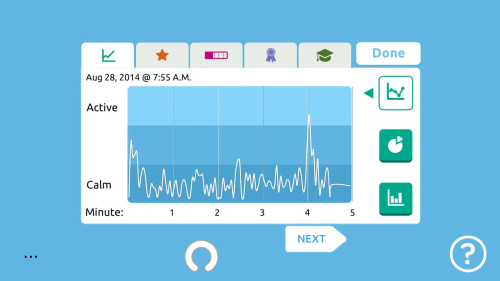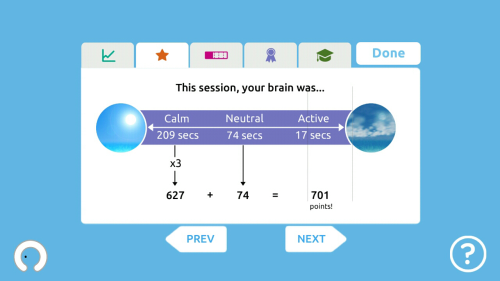Timothy Ferriss's Blog, page 102
September 12, 2014
Can You Rewire Your Brain In Two Weeks? One Man’s Attempt…

Can you rewire your brain in two weeks? The answer appears to be — at least partially — yes.
The following is a guest post by Shane Snow, frequent contributor to Wired and Fast Company and author of the new book SMARTCUTS: How Hackers, Innovators, and Icons Accelerate Success. Last year, he wrote about his two-week Soylent experiment, which went viral and racked up 500+ comments. He knows how to stir up controversy.
In this post, Shane tests the “brain-sensing headband” called Muse.
It’s received a lot of PR love, but does it stand up to the hype? Can it make you a calmer, more effective person in two weeks? This post tackles these questions and much more.
As many of your know, I’m a long-time experimenter with “smart drugs,” which I think are both more valuable and more dangerous that most people realize. This includes homemade brain stim (tDCS) devices (I wouldn’t recommend without supervision) and other cutting-edge tools. If you’d like to read more on these topics, please let me know in the comments.
In the meantime, I hope you enjoy Shane’s experimentation!
Enter Shane Snow
The electrodes needed to be adjusted to fit my sweaty head, which was apparently the largest size the product could accommodate.
I was sitting on a porch in palpable D.C. humidity, on a midsummer’s morning at Bolling Air Force Base, trying to get a quartet of EEG sensors to connect my brain to my Samsung Galaxy. The purple box on my screen kept blinking in and out of sync.
Inside the house, my friend’s two-year-old was jumping violently on the sofa—the same sofa that the shedding 15-pound cat named Endai and I had shared for the past week. The house was in shambles; movers were busily trucking everything away to my friend’s soon-to-be new home in New Mexico. Hence the porch.
I had been sleeping on said couch due to the abrupt ending of an 8-year relationship, which had left me stunned and homeless for the preceding three weeks. As luck would have it, the anti-anxiety pills my shrink had prescribed for me to take “as needed” were back in New York in my friend Simon’s living room. Crap. My calendar had just alerted me that I’d missed the Skype call start time for my company board meeting, right before the movers unplugged the Internet. Meanwhile, a platoon of military helicopters had decided to play what appeared to be a game of “who can hover the longest over the neighborhood”. Chuk, chuk, chuk, chuk, chuk. CHUCK. CHUCK.
My stress levels were high.
Seemed like as good a time as any to try out my new gadget: a brainwave-sensing headband called the Muse, and its companion app, Calm.
I placed the band’s centimeter-wide contact strip of electrodes against my forehead and rested the plastic against the top of my ears, fiddling with the fit until my phone finally registered a solid connection for each of the sensors, two on my temples, two behind my ears. I donned my white Audio-Technica DJ headphones and fired up the app, which in a soothing voice instructed me to sit up straight, and breeeeeeeathe.
Calm is a simple meditation exercise: Count your breaths. Don’t try to force them. Your body knows how to breathe. Simply pay attention, the female voice in my headphones told me. After Muse calibrated to my brain’s “active” state—by making me brainstorm items in a series of topics—I was given five minutes of nature sounds to breathe to. When calm and focused, I enjoyed the sound of lapping waves and birds tweeting; when my mind wandered, sturdy winds picked up and the birds flew away.
At the end of five minutes, the app confirmed: I am not very calm.
Thus began my two week experiment in brain therapy. I’d been planning on acquiring a Muse after having caught wind of its development nearly two years before, but who knew it would finally be released during the most anxious time of my adult life? Two weeks was plenty of time, Muse inventor Ariel Garten told me, for the Muse focus training exercises “to reduce perception of pain, improve memory, improve affect, reduce anxiety, and also improve emotional intelligence.”
Seemed a little good to be true, but I was willing to test it.
Electroencephalography (EEG—the recording of electrical activity emitted from the brain) has come a long way in the last 100 years, since doctors drilled holes in monkeys heads to attach sensors, and eventually glued contacts with cathode ray tubes to intact human skulls to map brain activity. They discovered that the brain emits oscillating signals of variable frequency, and the frequency of the oscillations indicates what’s happening—at a high level—in one’s mind. These “waves” are generally delineated into categories based on frequency ranges:
Delta waves: indicate deep sleep. (1-3 Hz)
Theta waves: indicate deep relaxation or meditation. (4-8 Hz)
Alpha waves: indicate a relaxed brain state, what Garten calls “an open state of mind.” (9-13 Hz)
Beta waves: indicate alert consciousness and fire up when you’re actively thinking. (14-30 Hz)
Gamma waves: indicate high alertness and are often associated with learning. (30-100 Hz)

Source: Wikimedia Commons
The original purpose of EEG was the study of epilepsy. Over the decades, however, as computers improved, neuroscientists’ increasing capability to process the enormous amount of data the brain throws off allowed them to experiment with EEG for other uses, such as attention therapy.
In his 2007 book, The Brain That Changes Itself, neuroscientist Norman Doidge made mainstream the then recent (and surprising) finding that “the brain can change its own structure and function through thought and activity.” Our intelligence and tendencies are not locked in once we’re no longer children, as popular belief once held. Once our brain was wired, it could still be rewired. Doidge called it, “the most important alteration in our view of the brain since we first sketched out its basic anatomy and the workings of its basic component, the neuron.”
This adaptability factor of the brain is called “neuroplasticity.” You may have seen dubious advertisements for “brain-enhancing games” and other gimmicks that drop the term neuroplasticity in impressive-sounding (but often meaningless) marketing speak. Despite this misuse, the plasticity of our neurons is, in fact, fact. Our brains use it to wire themselves naturally, but in the past several years scientists have developed a simple procedure to “hack” them.
Neurofeedback training, or NFT as the scientists call it, is a conditioning method wherein a patient is hooked up to an EEG and shown how active her brain is, thus allowing her to concentrate on exercises that exploit neuroplasticity to build mental muscles that allow her to consciously affect her resting brain activity. Clinical studies have shown that NFT helps the majority of patients to improve their cognitive control and have also helped ADHD sufferers significantly improve their ability to focus. NFT has even been shown to have a positive effect on depression.
The two prerequisites to being able to pull off NFT are EEG sensors and a computer processor that can turn an EEG scan into real-time feedback. The electricity coming off the brain is orders of magnitude weaker than a standard AA battery, which means sensors must be powerful, delicate, and well-attached to pick anything up. Doctors have found that the skull reduces the signal significantly and thus would prefer if we didn’t have skulls (for examination purposes, that is), but have mostly settled on using wet sensors—electrodes affixed to the scalp or forehead using conductive gel.
The breakthrough that enabled a more practical, portable EEG device like the Muse claims to be, was the advent of dry sensors, or metal contacts that can use the skin’s own moisture or sweat to attain the necessary conductivity.
“Brain waves are very, very, very quiet. They’ve had to make their way all the way through your thick, thick skull,” Garten says. But sensor technology is improving at a rate that indicates we’re two to three years away from non-contact sensors, she predicts.
And in 2014, processing power is no longer a problem. “Ten years ago we were using fiber optic cable to make sure that you got this extraordinary data into what was like an egg carton and an ancient Commodore computer so that they could do all the processing,” Garten says. “Now, we can just use a phone and Bluetooth.”

The 2013 Muse prototype
When I’d first laid hands on the Muse a year and a half before, it was a chunky slab of plastic and metal. Garten and I met up at a design gallery in Manhattan for a demo of the prototype headband she’d been working on for the better part of the last decade. A Canadian fashion designer turned neuroscientist, she spoke earnestly about the potential applications for measuring one’s brainstate to ameliorate stress and perhaps one day cure ADHD and anxiety.
Garten’s prototype Muse measured the activity of these waves and output them to an iPad like a seismograph. After I donned the plastic headband, I watched in real time as slowing my breathing or concentrating on something or simply talking affected the different wave forms.
“The long term vision is this tool is going to be a regular part of our daily lives,” Garten told me. “You know, like pedometers that help people manage and understand their physical exercise. Brain health is going to be something that is on everybody’s mind. Up until now, there has been no way to, basically, like put a stethoscope up to your brain and say, ‘How is it doing?’”
Ten years ago, a NFT system with Muse-like capabilities (often found in a chiropractor’s office) would cost 5 figures and a closet-worth of space. Now the processing power lives on a standard smartphone, and Muse sensors cost $299.
Eventually, Garten predicted, doctors would actively use it to treat the mentally ill. Programmers would build brainwave-control apps for gaming and smart homes and surfing the Internet on top of Muse’s technology.
But for now it just gives you tweety birds.
My porch session resulted in precisely zero of them:
This session, for which I got a score of “31% calm,” would be the first of many mental workouts in my DYI NFT experiment. Would regular usage of the Muse headband actually change my brain and help fix my anxious life? Or would it turn out to be another wearable that’s more hype than help?
THE EXPERIMENT
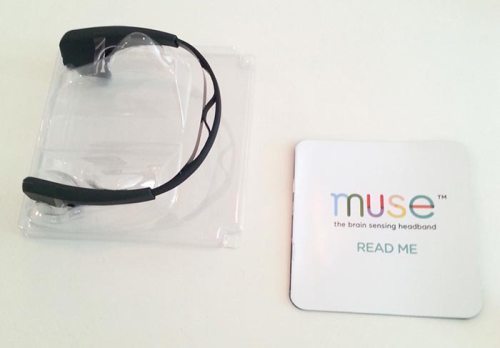
The 2014 Muse headband
The hypothesis (aka sales pitch) was that by using Muse, I’d improve my ability to focus and maintain my cool during my stressful day-to-day.
So for fifteen days, I performed a five-minute Muse Calm session each morning within an hour of waking up and shaking off sleep. I’d sit in a similar setting (straight-back chair in a room alone), in similar clothing (comfortable, shorts and t-shirt, no shoes), with no distractions (accomplished via Bose noise-canceling earbuds) every time.
Additionally, I performed a series of sessions in various random non-comfortable settings, to test whether different mental exercises produced different results, or whether I could remain calm while being assaulted by various outside forces—which is the real goal of NFT, rather than simply getting better at a “game” in quiet isolation.
Though the app would tell me if my brain was getting better at calming itself during the exercise, the less easy-to-quantify result would be to see whether my level of general anxiety would decrease as I got better at the Calm app. (I.e. am I forming these alleged neural pathways?) Garten and Calm each told me that once I completed enough sessions (5,000 points’ worth), the app would unlock insights about how my brain was doing, which could shed some light on my meta-state. But I also tracked my overall emotional and mental state by keeping regular journal entries throughout the two weeks.
For a control—and as a basic BS test—I performed a session while reading a book instead of doing the breathing exercise. I read three pages of Murakami’s new one, Colorless Tsukuru Tazaki, and my brain was all sorts of active. Mr. Murakami, your work is stimulating. Science hath proven it:
THE RESULTS
Most of my morning sessions took place between 8 and 11 a.m. I keep a somewhat irregular sleep schedule (a source of anxiety, or symptom?), but aim for 7 hours a night. The important part for this experiment was to make sure that I did my Muse session within an hour of waking, but after I had stopped being groggy. In other words: before my morning exercise, after my morning pee.
I kept the morning schedule up with a few exceptions: on August 18, the Muse Calm app caused the headband to think my brainwaves had completely flatlined. I contacted the Muse team, and they confirmed that this was indeed a bug that they were working on fixing that day. On August 20, 22, 24, and 26 I skipped my morning session due to extenuating circumstances. (The 24th, for example, was my birthday, and I stayed out until 8 a.m.. My first session that day was at 4 p.m. and resulted in a hangover-level 31%.) But throughout my 15-day experiment, I never went a day without doing one or more sessions, and I never went two days without doing a standardized morning session.
In all, I completed 24 sessions. Here’s how my morning sessions went over the course of the two weeks:
You’ll notice that I did pretty poorly for the first several sessions, then experienced a jump in improvement on August 17. What this chart doesn’t show is that though it was that August 17 was actually the seventh session I’d done in total. So I was getting better, but I’m not entirely sure why such a dramatic jump. You’ll also notice a slight dip on the 25th and 27th. On these days, I was having a couple of particularly anxious mornings (due to personal issues); however, on these days I still maintained double the calm as my first few sessions—which were less emotionally fraught than these days.
My final morning session of the experiment, on August 28, was a serene 89%—my best yet, and just one spike of brain activity away from monk-like zen:
More importantly, I attracted a fucking flock of tweety birds:
Here’s how I performed on my random sessions in less-controlled environments:
Clearly, it was harder for me to focus and remain calm when I was tired or emotionally compromised.
Trains made it easier to focus (likely due to the lack of noise and abundance of leg room). Airplanes tend to give me claustrophobia, but it’s also likely that the vibrations of the plane itself caused my muscles to move (generating louder electrical signals than your brain emits) and made my results so poor during the flight. There certainly was a lot of shaking going on during my flight.
Interestingly, listening to calming music (I tend to put Blackmill’s “Miracle” album on repeat when I want to relax or single-task) outperformed no sound (simply trying to calm myself without an aid). On August 27, my regular session with the app’s wind and waves, resulted in 12% less calm than my music experiment immediately after.
As far as the meta, “how am I doing” portion of the experiment went, I eagerly awaited when I could unlock the “Insights About You” page of the app, after racking up enough “calm points”. Disappointingly, though Garten and Muse Calm both promised me these “additional features and special insights into my brain”, once I unlocked the screen, I got simply a blank, broken page:
When asked, the Muse publicist confirmed that the feature “actually hasn’t been developed yet” and relayed the (in my opinion) unlikely explanation that “there was a miscommunication between the product and dev teams.”
My journal entries indicated a general decrease in agitation and worry by the end of the experiment. My ability to focus on tasks (primarily writing) seemed to improve. I have a tendency to get distracted when I’m writing, and in the same way that the waves-and-wind exercise in the app teaches you to power through distractions and focus on your breath, I felt that I already was improving my ability to notice a distraction but keep it in the background instead of indulging it.
Furthermore, as I walked down busy streets or lay in bed—times when I normally would ruminate—I found myself subconsciously slowing breaths and counting them as a means of shoving out bad thoughts and calming down.
“Many smart people who use their brains a lot are ‘high beta,’” explained my therapist (whose name I’ll omit to maintain a shred of personal privacy) when I asked her about this. An award-winning Manhattan psychologist and author, she has used NFT herself. A few years ago, she used a professional-grade version of Muse to teach her own active brain to be silent. “I couldn’t go to sleep without the TV on,” she said. “The minute it was quiet, my brain would explode with activity.”
With measurement and some mental situps, she calmed her own rumination—as apparently thousands of people have done at clinics that use EEG therapy. That “neuroplasticity” thing that people throw around, it turns out, is real. And it works as fast as one can form a bad habit.
“The brain can be retrained,” she said. “People think it can’t, but it can.”
POTENTIAL ISSUES
One of the main limitations of the Muse Calm app—or at least questions that I had from the beginning—was the validity of the wind-and-waves feedback sound system itself, as well as the “count your breaths” mediation exercise. My assistant, Erin, who’s a yoga instructor and meditation expert by night, was skeptical that the Muse Calm exercise was the most effective method the app could have chosen. Why would you have the distracting sounds get worse when you were most compromised? she said. Doesn’t that create a self-defeating cycle?
Garten responded: “We did a bunch of experimentation on positive reinforcement and negative reinforcement and we ultimately built an application with a mix of both. The negative reinforcements of the wind can definitely be distracting, but what you learn over time is also this lesson in not being judgmental when things don’t work.”
A 2010 study by scientists from the University of Pennsylvania and Georgetown found positive links between “mindfulness training”—the popular meditation practice of calmly noticing, but not changing what’s happening to you—has a positive effect on working memory. The Muse Calm’s “notice and count your breaths” exercise is a form of mindfulness training, and appears to hold up under scientific scrutiny, but the wind-and-waves feedback loop (NFT) throws a bit of a wrench into true “mindfulness”, since the act of being mindful ends up affecting your environment, whereas the point of mindfulness meditation is to notice but not affect.
Could a “pure” mindfulness exercise without the instant and self-reinforcing feedback outperform Calm’s NFT/mindfulness hybrid? Beats me, but it’s a question I’d want to test in future experiments.
Other limitations or potential variables that could affect the science behind my two-week experiment include the following:
Factors such as the exact time I awoke and what kind of bed I slept in changed slightly from day to day, as I was traveling and couch-hopping. While the course of my experiment showed an upward trend in calm, I wasn’t able to duplicate the time and setting of each of my morning sessions precisely, which could affect the results to some degree.
Since I was dealing with the fresh personal trauma, perhaps I was naturally recovering psychologically during the two weeks of my experiment (i.e. regression to the mean). My therapist insists that the relationship wound was too fresh and two weeks is not enough time to work through anything, but it still could be a factor.
This experiment was only two weeks, which I was told would be a sufficient minimum for results. More time could certainly help verify the trends I observed in my short experiment. (And I plan to keep using Muse over the next few months to track just that.)
And of course, my observations about how I was feeling were, by nature, subjective. (However, if my psychological improvement is all in my head, that’s okay by me—it was in my head to begin with! And actually, I’ve interviewed one scientist who’s studying how placebos actually form neural pathways that can physically cure psychological issues. Very interesting stuff happening in this field.)
EPILOGUE
The electrodes had no problem beaming the signal from my sweaty head to my Android this time.
I was sitting on a set of red bleachers in disgusting New York humidity in the middle of Times Square, Manhattan. The familiar female voice in my headphones instructed me to close my eyes, as she had two dozen times before.
Around me, a trillion stressed-out tourists were busily taking selfies and worrying about pick pockets. A troupe of Chinese activists had just accosted me with pamphlets and signs concerning some “Jesuit Father discrimination” something-or-other, meanwhile a quartet of feather-headressed ladies performed a synchronized dance on the steps below me. A bumblefoot pigeon had taken up residence on my step and didn’t seem to want to leave me alone. My entire body was sweating.
I’d just walked through my old neighborhood, a surprisingly painful reminiscence. Unexpectedly, one of my ex’s favorite songs had begun playing on shuffle as I made my way through the crowd, further dampening my mood. In the back of my head were the several overdue stories for editors of various publications in line with my book launch, and the approximately 200 priority emails stacked up in my inbox. I was lugging my entire life in an overstuffed backpack and had just spilled protein drink all over my shorts—which I just now realized were my only available leggings, because I’d left the remaining two pairs of jeans I owned back in my friend Simon’s freezer (here’s why). I was pensive and hot and frustrated and dripping.
Once again, I donned my brainwave headband, which once again told me to breeaaathe.
About halfway through my five-minute session—the twenty-fifth I’d undertaken since meeting Muse—some nearby tourists began singing “Happy Birthday” so loudly that I could hear them through my noise-canceling headphones. A fire engine blared its siren in place for a full minute, stuck one block away in Times Square traffic. My butt burned on the red steps, in the August heat. My posture was killing me.
At the end of five minutes, Muse confirmed: I was pretty damn calm.
The two spikes in active brain activity in this chart were the fire truck and the birthday party, each of which I recovered from almost instantly. Aside from that, my brain state was either neutral or calm the entire time:
Plus I attracted 15 tweety birds:
Despite the chaos in my life, there was no doubt that this little device had made me a calmer person in just two weeks. I could play through the mental and physical pain with twice the composure as just fifteen days before.
Muse has a way to go before the guy with the electric headband on in Times Square doesn’t just look like an idiot. And the Calm app could definitely use work. (Different meditation exercises, please?) However, the science behind what the Muse team is doing is real, the technology promising, and a bevy of independent programmers are already building fascinating applications on top of Muse.
With the development of cheap and portable EEG monitors like Muse, are we a few lines of code away from controlling light switches and video games with our brains? It’ll take a while.
But I, at least, am a step closer to mind over matter.
Breeeeathe….
###
Question of the day: What do you think are the next frontiers of self-experimentation and self-tracking? What would you like me to test for you? Please let me know in the comments by clicking here.

September 9, 2014
The Tim Ferriss Show: Interview with Peter Thiel, Billionaire Investor and Company Creator

“Freedom lies in being bold.” – Robert Frost
This episode’s guest is the incredible Peter Thiel.
Peter is a serial company founder (PayPal, Palantir), billionaire investor (first outside investor in Facebook, 100+ others), and author of the new book Zero to One. Whether you’re an investor, entrepreneur, or simply a free thinker aspiring to do great things, I highly recommend you grab a copy. His teachings on differentiation, value creation, and competition alone have helped me make some of the best investment decisions of my life (e.g. Twitter, Uber, Alibaba, etc.).
This podcast episode was experimental, as I was on medical leave. It includes both audio and written questions. What are Peter’s favorite books? Thoughts on tech and government, and more? Answers to these “bonus questions” can be found in the text below.
For the longer, main audio discussion, you can:
Listen to the episode on iTunes
Download it as an MP3 (right click “save as”): Here it is.
Or stream it now below (If you’re reading this in e-mail, please click here to stream):
Now, a bit more on Peter…
Peter Thiel has been involved with some of the most dynamic companies to emerge from Silicon Valley in the past decade, both as a founder and investor. Peter’s first start-up was PayPal, which he co-founded in 1998 and led to a $1.5 billion acquisition by eBay in 2002. After the eBay acquisition, Peter founded Clarium Capital Management, a global macro hedge fund. Peter also helped launch Palantir Technologies, an analytical software company which now books $1B in revenue per year, and he serves as the chairman of that company’s board. He was the first outside investor in Facebook, and he has invested in more than 100 startups total.
There are a lot of lessons in this podcast, even more in his new book, and below are a few follow-up questions that Peter answered via text.
Enjoy!
TIM: What is the book (or books) you’ve most often gifted to other people?
PETER: Books by René Girard, definitely — both because he’s the one writer who has influenced me the most and because many people haven’t heard of him.
Girard gives a sweeping view of the whole human experience on this planet — something captured in the title of his masterwork, Things Hidden Since the Foundation of the World — but it’s not just an academic philosophy. Once you learn about it, his view of imitation as the root of behavior is something you will see every day, not just in people around you but in yourself.
What is your favorite movie or documentary?
PETER: No Country for Old Men — a movie about whether all events are simply random, but also a work in which no detail is left to chance. I catch something new every time I watch it.
To increase technological growth/progress, what are the key things you think the government or people should do for greatest impact?
PETER: Libertarians like to call out excessive regulations, and I think they’re right.
But it’s a vicious circle: when governments make it harder to get things done, people come to expect less; when expectations are low, technologists are less likely to aim high with the kind of risky new ventures that could deliver major progress. The most fundamental thing we need to do is regain our sense of ambition and possibility.
For those who want to improve their ability to question assumptions or commonly held “truths,” which philosophers, or reading, or exercises, or activities might you suggest?
PETER: It’s a great exercise to revisit predictions about the future that were made in the past.
People write a lot of history, and they make a lot of predictions, and I consume a lot of both. But it’s rare that people go and check old predictions. It’s a way to see — with the benefit of hindsight — the assumptions that people didn’t even know they were making, and that can make you more sensitive to the questionable conventions that surround us today. For example, The American Challenge by Jean-Jacques Servan-Schreiber argued in 1968 that Europe would be eclipsed by relentless American progress. But that progress never came. It’s instructive to go back and see why Servan-Schreiber was optimistic.
###
Now, some questions for you all…
Who should I interview next? Please let me know in the comments by clicking here.
Do you enjoy this podcast? If so, please leave a short review here. Help me get to 1,000! It’s so close!
Subscribe to The Tim Ferriss Show on iTunes.
Non-iTunes RSS feed

August 29, 2014
The Tim Ferriss Show: Interview of Kevin Kelly, Co-Founder of WIRED, Polymath, Most Interesting Man In The World?

This single interview — one of my favorites of all-time — was recorded in three short parts. You can:
Listen to all three on iTunes
Download them as MP3s (right click “save as”): Part 1, Part 2, Part 3.
Or stream them now below (If you’re reading this in e-mail, please click here to stream):
This podcast is brought to you by The Tim Ferriss Book Club, which features a handful of books that have changed my life. Here’s the list. You can also find all 20+ episodes of this podcast here. Some are sober and some are drunk, but the guests are all great.
Now, on to this episode’s guest…
Kevin Kelly might be the real-life Most Interesting Man In The World.
He is Senior Maverick at Wired magazine, which he co-founded in 1993. He also co-founded the All Species Foundation, a non-profit aimed at cataloging and identifying every living species on earth. In his spare time, he writes bestselling books, co-founded the Rosetta Project, which is building an archive of ALL documented human languages, and serves on the board of the Long Now Foundation. As part of the last, he’s investigating how to revive and restore endangered or extinct species, including the Wooly Mammoth.
This episode touches on a lot of cool stuff. SERIOUSLY, A LOT.
Just scroll below and your head might explode. Tons of amazing links and goodies…
Enjoy!
Who should I interview next? Please let me know in the comments by clicking here.
Do you enjoy this podcast? If so, please leave a short review here. It keeps me going…
Subscribe to The Tim Ferriss Show on iTunes.
Non-iTunes RSS feed
Show Notes and Select Links from the Episode
Kevin Kelly’s biggest regret
His lesson in finding contentment in minimalism and “volunteer simplicity”
How he realized that writing actually creates ideas
Why he promised himself that he would never resort to teaching English while traveling abroad
The “creator’s dilemma,” or how you have to go lower to get higher
Why you don’t want to be a billionaire
His realizations after doing a “6 months until death” challenge
His Kickstarter-funded project linking angels and robots
Why a self-proclaimed ex-hippie waited until his 50th birthday to try LSD for the first time
Why a population implosion is probable in the next 100 years
The greatest gift you can give to your child
The criteria for Amish technology assimilation
What technology-free sabbaticals can do for you
Long Now Foundation’s vision of a better civilization
The graphic novel for young people on how to become indispensable
His favorite fiction book
The great resource Kevin compiled for documentary lovers
How he accumulated enough books to fill a two-story library
Mythbuster’s Adam Savage’s organizational method, which transformed Kevin’s life
The project that everyone should undertake at least once in life
The advice he would give to his younger self
LINKS FROM THE EPISODE
Visit the Tim Ferriss Book Club to find a new book each month (or so) that’s changed my life
Wired Magazine
Learn more about the All Species Foundation
The Rosetta Project
Long Now Foundation
Get more information about 1,000 True Fans
Learn more about Voluntary Simplicity
This American Life, Episode 50 with Kevin Kelly
Tim Ferriss Show Episode 2: Interview with Josh Waitzkin
True Films – Kevin Kelly’s site about documentaries
Learn more about sodium valproate
www.Uline.com – shipping, industrial, and packing materials
Adam Savage – host of Mythbusters
Elance – resource for hiring freelancers
Whole Earth Catalog
KK.org – Kevin Kelly’s website
Books Mentioned in the Episode
Cat’s Cradle by Kurt Vonnegut
Vagabonding: An Uncommon Guide to the Art of Long-Term World Travel by Rolf Potts
Cool Tools: A Catalog of Possibilities by Kevin Kelly
What Technology Wants by Kevin Kelly
The Psychedelic Explorer’s Guide by Kevin Kelly
The Adventures of Johnny Bunko by Daniel H. Pink
So Good They Can’t Ignore You by Cal Newport
Shantaram: A Novel by Gregory David Roberts
Searching for Bobby Fischer: The Father of a Prodigy Observes the World of Chess by Fred Waitzkin
True Films by Kevin Kelly
Documentaries Mentioned in the Episode
Man on Wire
King of Kong
State of Mind

August 25, 2014
The Art of Strategic Laziness

David Heinemeier Hansson (“DHH”)
The following is a guest post by Shane Snow, a frequent contributor to Wired and Fast Company. Last year, he wrote about his two-week Soylent experiment, which went viral and racked up 500+ comments.
This post is adapted from his new book, SMARTCUTS, and it will teach you a few things:
How to use strategic “laziness” to dramatically accelerate progress
How “DHH” became a world-class car racer in record time, and how he revolutionized programming (they’re related)
A basic intro to computer programming abstraction
Note: the technical aspects of programming have been simplified for a lay audience. If you’d like to point out clarifications or subtleties, please share your thoughts in the comments! I’d love to read them, as I’m thinking of experimenting with programming soon.
Enter Shane Snow
The team was in third place by the time David Heinemeier Hansson leapt into the cockpit of the black-and-pink Le Mans Prototype 2 and accelerated to 120 miles per hour. A dozen drivers jostled for position at his tail. The lead car was pulling away from the pack—a full lap ahead.
This was the 6 Hours of Silverstone, a six-hour timed race held each year in Northamptonshire, UK, part of the World Endurance Championship. Heinemeier Hansson’s team, Oak Racing, hoped to place well enough here to keep them competitive in the standings for the upcoming 24 Hours of Le Mans, the Tour de France of automobile racing.
Heinemeier Hansson was the least experienced driver among his teammates, but the Oak team had placed a third of this important race in his hands.
Determined to close the gap left by his teammate, Heinemeier Hansson put pedal to floor, hugging the curves of the 3.7-mile track that would be his singular focus for the next two hours. But as three g’s of acceleration slammed into his body, he began to slide around the open cockpit. Left, then right, then left. Something was wrong with his seat.
In endurance racing, a first place car can win a six- or 12-hour race by five seconds or less. Winning comes down to two factors: the equipment and the driver. However, rules are established to ensure that every car is relatively matched, which means outcomes are determined almost entirely by the drivers’ ability to focus and optimize thousands of tiny decisions.
Shifting attention from the road to, say, a maladjusted driver’s seat for even a second could give another car the opportunity to pass. But at 120 miles per hour, a wrong move might mean worse than losing the trophy. As Heinemeier Hansson put it, “Either you think about the task at hand or you die.”
Turn by turn, he fought centrifugal force, attempting to keep from flying out while creeping up on the ADR-Delta car in front of him.
And then it started to rain…
***
When Heinemeier Hansson walked onto the racing scene in his early 30s, he was a virtual unknown, both older and less experienced than almost anyone in the leagues. A native of Denmark, he’s tall, with a defined jaw and dark spikey hair. At the time he raced 6 Hours of Silverstone, it had been about five years since he first drove any car at all.
That makes him one of the fastest risers in championship racing.
Despite that, Heinemeier Hansson is far better known among computer programmers—where he goes by the moniker DHH— than car enthusiasts. Though most of his fellow racers don’t know it, he’s indirectly responsible for the development of Twitter. And Hulu and Airbnb. And a host of other transformative technologies for which he receives no royalties. His work has contributed to revolutions, and lowered the barrier for thousands of tech companies to launch products.
All because David Heinemeier Hansson hates to do work he doesn’t have to do.
DHH lives and works by a philosophy that helps him do dramatically more with his time and effort. It’s a principle that’s fueled his underdog climbs in both racing and programming, and just might deliver a win for him as the cars slide around the rainslicked Silverstone course.
But to understand his smartcut, we must first learn a little bit about how computers work.
Think of the way a stretch of grass becomes a road. At first, the stretch is bumpy and difficult to drive over. A crew comes along and flattens the surface, making it easier to navigate. Then, someone pours gravel. Then tar. Then a layer of asphalt. A steamroller smooths it; someone paints lines. The final surface is something an automobile can traverse quickly. Gravel stabilizes, tar solidifies, asphalt reinforces, and now we don’t need to build our cars to drive over bumpy grass. And we can get from Philadelphia to Chicago in a single day.
That’s what computer programming is like. Like a highway, computers are layers on layers of code that make them increasingly easy to use. Computer scientists call this abstraction.
A microchip—the brain of a computer, if you will—is made of millions of little transistors, each of whose job is to turn on or off, either letting electricity flow or not. Like tiny light switches, a bunch of transistors in a computer might combine to say, “add these two numbers,” or “make this part of the screen glow.”
In the early days, scientists built giant boards of transistors, and manually switched them on and off as they experimented with making computers do interesting things. It was hard work (and one of the reasons early computers were enormous).
Eventually, scientists got sick of flipping switches and poured a layer of virtual gravel that let them control the transistors by typing in 1s and 0s. 1 meant “on” and 0 meant “off.” This abstracted the scientists from the physical switches. They called the 1s and 0s machine language.
Still, the work was agonizing. It took lots of 1s and 0s to do just about anything. And strings of numbers are really hard to stare at for hours. So, scientists created another abstraction layer, one that could translate more scrutable instructions into a lot of 1s and 0s.
This was called assembly language and it made it possible that a machine language instruction that looks like this:
10110000 01100001
could be written more like this:
MOV AL, 61h
which looks a little less robotic. Scientists could write this code more easily.
Though if you’re like me, it still doesn’t look fun. Soon, scientists engineered more layers, including a popular language called C, on top of assembly language, so they could type in instructions like this:
printf(“Hello World”);
C translates that into assembly language, which translates into 1s and 0s, which translates into little transistors popping open and closed, which eventually turn on little dots on a computer screen to display the words, “Hello World.”
With abstraction, scientists built layers of road which made computer travel faster. It made the act of using computers faster. And new generations of computer programmers didn’t need to be actual scientists. They could use high-level language to make computers do interesting things.
When you fire up a computer, open up a web browser, and buy a copy of my book online for a friend (please do!), you’re working within a program, a layer that translates your actions into code that another layer, called an operating system (like Windows or Linux or MacOS), can interpret. That operating system is a probably built on something like C, which translates to Assembly, which translates to machine language (1s and 0s), which flips on and off a gaggle of transistors.
(Phew.)
So, why am I telling you this? In the same way that driving on pavement makes a road trip faster, and layers of code let you work on a computer faster, hackers like DHH find and build layers of abstraction in business and life that allows them to multiply their effort.
I call these layers platforms.
***
At college in the early aughts, DHH was bored. Not that he couldn’t handle school intellectually. He just didn’t find very much of it useful.
He practiced the art of selective slacking. “Some of my proudest grades were my lowest grades,” he tells me.
We all know people in school and work with a masterful ability to maintain the status quo (John Bender on The Breakfast Club or the bald, coffee-swilling coworker from Dilbert), but there’s a difference between treading water and methodically searching for the least wasteful way to learn something or level up, which is what DHH did.
“My whole thing was, if I can put in 5 percent of the effort of somebody getting an A, and I can get a C minus, that’s amazing,” he explains. “It’s certainly good enough, right? [Then] I can take the other 95 percent of the time and invest it in something I really care about.”
DHH used this concept to breeze through the classes that bored him, so he could double his effort on things that mattered to him, like learning to build websites. With the time saved, he wrote code on the side.
One day, a small American web-design agency called 37signals asked DHH to build a project management tool to help organize its work. Hoping to save some time on this new project, he decided to try a relatively new programming language called Ruby, developed by a guy in Japan who liked simplicity. DHH started coding in earnest.
Despite several layers of abstraction, Ruby (and all other code languages) forces programmers to make countless unimportant decisions. What do you name your databases? How do you want to configure your server? Those little things added up. And many programs required repetitive coding of the same basic components every time.
That didn’t jibe with DHH’s selective slacking habit. “I hate repeating myself.” He almost spits on me when he says it.
But conventional coders considered such repetition a rite of passage, a barrier to entry for newbies who hadn’t paid their dues in programming. “A lot of programmers took pride in the Protestant work ethic, like it has to be hard otherwise it’s not right,” DHH says.
He thought that was stupid. “I could do a lot of other interesting things with my life,” he decided. “So if programming has to be it, it has to be awesome.”
So DHH built a layer on top of Ruby to automate all the repetitive tasks and arbitrary decisions he didn’t want taking up his time. (It didn’t really matter what he named his databases.) His new layer on top of programming’s pavement became a set of railroad tracks that made creating a Ruby application faster. He called it Ruby on Rails.
Rails helped DHH build his project—which 37signals named Basecamp—faster than he could have otherwise. But he wasn’t prepared for what happened next.
When he shared Ruby on Rails on the Internet, programmers fell in love with it. Rails was easier than regular programming, but just as powerful, so amateurs downloaded it by the thousands. Veteran coders murmured about “real programming,” but many made the switch because Rails allowed them to build their projects faster.
The mentality behind Rails caught on. People started building add-ons, so that others wouldn’t have to reinvent the process of coding common things like website sign-up forms or search tools. They called these gems and shared them around. Each contribution saved the next programmer work.
Suddenly, people were using Ruby on Rails to solve all sorts of problems they hadn’t previously tackled with programming. A toilet company in Minnesota revamped its accounting system with it. A couple in New Jersey built a social network for yarn enthusiasts. Rails was so nice that more people became programmers.
In 2006 a couple of guys at a podcasting startup had an idea for a side project. With Rails, they were able to build it in a few days—as an experiment—while running their business. They launched it to see what would happen. By spring 2007 the app had gotten popular enough that the team sold off the old company to pursue the side project full time. It was called Twitter.
A traditional software company might have built Twitter on a lower layer like C and taken months or years to polish it before even knowing if people would use it. Twitter—and many other successful companies—used the Rails platform to launch and validate a business idea in days. Rails translated what Twitter’s programmers wanted to tell all those computer transistors to do—with relatively little effort. And that allowed them to build a company fast. In the world of high tech—like in racing—a tiny time advantage can mean the difference between winning and getting passed.
Isaac Newton attributed his success as a scientist to “standing on the shoulders of giants”—building off of the work of great thinkers before him.
Platforms are tools and environments that let us do just that. It’s clear how using platforms applies in computer programming, but what if we wanted to apply platform thinking to something outside of tech startups?
Say, driving race cars?
***
David Heinemeier Hansson was in a deep hole. Halfway through his stint, the sprinkling rain had become a downpour. Curve after curve, he fishtailed at high speed, still in third place, pack of hungry competitors at his rear bumper.
LMP cars run on slick tires—with no tread—for speed. The maximum surface area of the tire is gripping the road at any moment. But there’s a reason street vehicles have grooves in them. Water on the road will send a slick tire drifting, as the smooth rubber can’t channel it away. Grooved tires push water between the tread, giving some rubber grip and preventing hydroplaning. The slicker the tires—and the faster the speed—the more likely a little water will cause a car to drift.
That’s exactly what was happening to the LMP racers. As the rain worsened, DHH found himself sliding around the inside of a car that was sliding all over the race track. Nearby, one driver lost grip, slamming into the wall.
Cars darted for the pits at the side of the track, so their teams could tear off the slick tires and attach rain tires. Rain tires are safer, but slower. And they take a precious 13-plus seconds to install. By the time the car has driven into the pits, stopped, replaced the tires, and started moving again, more than a minute can be lost.
DHH screamed into his radio to his engineer, Should I pit in for new tires?
Like I said, DHH wasn’t the most experienced racer. He had gotten into this race because he was skilled at hacking the ladder. A few years into 37signals’s success, and with Rails taking a life of its own, Hansson had started racing GT4—essentially souped-up street cars—in his spare time.
Initially, he finished in the middle of the pack with the other novices. But after studying videos of master drivers, he started placing higher. High enough that after six races, he was allowed to enter into GT3 races (the next level up), despite zero first-place wins. In GT3, he raced another six times, placing first once, third another time. He immediately parlayed up to GTE (the “E” is for “endurance”). While other racers duked it out the traditional way, spending a year in each league, and only advancing after becoming league champion, DHH “would spend exactly the shortest amount of time in any given series that I could before it was good enough to move up to the next thing.”
There’s no rule that says you have to win the championship to advance from GT4 to GT3. Nor is there a rule saying you have to spend a year in a given league before moving up. That’s just the way people did it. Instead, DHH compressed what normally takes five to seven years of hard work into 18 months of smart work. “Once you stop thinking you have to follow the path that’s laid out,” he says, “you can really turn up the speed.”
On the rainy Silverstone course, however, parlays couldn’t help him anymore, and slacking was not an option. DHH had to drive as fast as safely possible, and every microsecond counted. In such tight competition, the only edge a racer had was raw driving skill.
Or, as it turned out, a better platform.
SHOULD I PIT IN? The man who hates repeating himself repeated over the radio. I’m going to end up in the wall!
His engineer told him to tough it out. The rain is about to clear up.
G-force pounding his body, DHH cautiously hugged the curves for another lap, and sure enough, the downpour began to subside. By two laps the course was dry. Heinemeier Hansson’s slick tires gripped the track with more friction than his competitors’ newly fitted rain tires and he sped ahead. The other drivers now had to pit back in for slick tires, for a total of nearly two minutes’ delay that DHH entirely avoided.
At the end of his leg of the relay, DHH jumped from the car, having demolished the competition.
The slick tires provided DHH a platform advantage, more leverage to drive faster with the same pedal-to-floor effort. And though driving slick in the rain had been risky, his skill learned by imitating master racers kept him alive.
Reflecting on his rapid ascent in racing, DHH says, “You can accelerate your training if you know how to train properly, but you still don’t need to be that special. I don’t think I’m that special of a programmer or a businessperson or a race car driver. I just know how to train.”
DHH had proven he had the skill to race. Videos of master drivers had helped him to learn quickly. His tire advantage had pushed him ahead of equally skilled drivers, and propelled him to the next level. And the advanced racing leagues themselves became a platform that forced him to master the basics—and faster—than he would have at a lower level.
When DHH returned to visit his home race track in Chicago, the same set of drivers still dominated the lower leagues.
He came back and effortlessly beat them.
***
Effort for the sake of effort is as foolish a tradition as paying dues. How much better is hard work when it’s amplified by a lever? Platforms teach us skills and allow us to focus on being great, rather than reinventing wheels or repeating ourselves.
“You can build on top of a lot of things that exist in this world,” David Heinemeier Hansson told me. “Somebody goes in and does that hard, ground level science-based work…”
“And then on top of that,” he smiles, “you build the art.”
###
Question of the day (QOD): What other selectively “lazy” innovators can you think of? People who’ve looked at problems in novel ways, or solved them in non-obvious ways? People who’ve opted for simplicity when most “experts” are choosing complexity?

August 22, 2014
The Random Show, Episode 25 — Gut Bacteria, Meditation, Startups, and More
If you can’t view the above video, please click here or here. To download the audio as an MP3, just right-click here and choose “save as.”
There are dozens of topics covered in this bromantic episode of scatterbrained banter.
Like what? To start off: tracking gut bacteria, favorite documentaries, keys for novice meditators, startup lessons, Kevin’s new obsessions, and more. O-tanoshimi dane!
The last few blog posts have been rather serious, so this is intended as an informal (but still informative) mind snack.
For all previous episodes of The Random Show, including the epic China Scam episode, click here.
Enjoy!
Select show notes and links are below. Some good stuff in this episode’s resources…
LINKS FROM THE EPISODE
Visit the Tim Ferriss Book Club to find a new book each month (or so) that’s changed my life
Interview with Kelly Starrett and Dr. Justin Mager on performance enhancement, athletics, and wine
uBiome – Explore your microbiome and optimize it…
My No-Soap, No-Shampoo, Bacteria-Rich Hygiene Experiment – NY Times article
How to Keep Feces Out of Your Bloodstream – Article by Robb Wolf
DonorsChoose.org
The 30-Day Challenge: No Booze, No Masturbating (NOBNOM)
Lift – The app that help you reach your goals
Headspace meditation app
Calm meditation app
Sam Harris, PhD on Spirituality, Neuroscience, Meditation, and More
www.SamHarris.org
Drugs and the Meaning of Life
Sup App – Explore the world through one-way live video!
Lumosity -Brain Games & Brain Training
Oculus Rift
Foundation.kr
Foundation Episode 36: Tony Fadell
www.Hodinkee.com – Top wristwatch blog
Swatch SISTEM51 wristwatch
Movies and Documentaries:
Bigger, Stronger, Faster
Anchorman
Stepbrothers
King of Kong
Man on Wire
Tiny the Movie
Screenplays:
Princess Bride
King’s Speech
Casablanca
Fear and Loathing in Las Vegas
Fight Club
Books Mentioned in the Episode
Grain Brain by David Perlmutter
Antifragile: Things That Gain from Disorder by Nassim Taleb
The Black Swan by Nassim Taleb
Fooled by Randomness by Nassim Taleb
Jesus’ Son: Stories by Denis Johnson
Snow Crash by Neal Stephenson
Cat’s Cradle by Kurt Vonnegut
What would you like us to talk about in the next episode? Anything we should test out and report back on?
Please click here and let us know in the comments!

August 19, 2014
The Truth About “Homeopathic” Medicine

Homeopathy — effective, useless, or dangerous? (Photo: Marcos Zerene)
[Audio version]
[Text version]
I routinely use an arnica gel for minor muscular strains. In fact, it’s one of my “go to” treatments.
In 2010, however, I found myself swallowing Boiron Arnica Montana 30C pellets, an oral version that was the only option at the closest GNC. I started at five pellets, SIX times a day–TWICE the recommended dose. Risk of overdose? Not likely.
“30C,” which I looked up that evening, tells you all you need to know.
This consumable version of arnica, unlike the creams I’d used in the past, was a homeopathic remedy. Samuel Hahnemann, a German physician, pioneered the field of homeopathy in 1796, if the term “pioneer” can be applied to alternative “medicine” founded on concepts like mass dilution and beatings with horse-hair implements. From the Wikipedia entry for “homeopathic dilutions,” last I looked:
Homeopaths use a process called “dynamisation” or “potentisation” whereby a substance is diluted with alcohol or distilled water and then vigorously shaken by ten hard strikes against an elastic body in a process called “succussion”… Hahnemann believed that the process of succussion activated the vital energy of the diluted substance.
Riiiight.
Back to 30C. 30C indicates a 10-60 (10^(-60), or 10 to the negative 60th) dilution, the dilution most recommended by Hahnemann.
30C would require giving 2 billion doses per second to 6 billion people for 4 billion years to deliver a single molecule of the original material to any one person. Put another way, if I diluted one-third of a drop of liquid into all the water on earth, it would produce a remedy with a concentration of about 13C, more than twice the “strength” of our 30C arnica.
Most homeopathic remedies in liquid are indistinguishable from water and don’t contain a single molecule of active medicine. In systematic review after systematic review, these dilutive homeopathic remedies display no ability to heal beyond placebo.
I found this particularly bothersome. Bothersome because I appeared to heal faster using oral 30C arnica.
There are a few potential explanations…
OPTION #1 — HOMEOPATHIC REMEDIES WORK AS ADVERTISED
The water actually retains some “essential property” of the original substance because of the beatings and shakings. I give this a probability of somewhere between zero and epsilon (where epsilon is almost zero). It violates the most basic laws of science and makes my head hurt.
NOTE: Some people use the term “homeopathic” interchangeably with “organic” or “herbal”; I am not addressing this misnomer nor the associated compounds. Some herbal, non-prescription medications have tremendous effects. I’m speaking only to the original use of the word “homeopathic” as related to dilutive treatments.
OPTION #2 — THE PLACEBO EFFECT
I didn’t realize it was a homeopathic remedy until after four or five doses, and I had been told it could reduce pain by up to 50% in 24 hours. Placebo is strong stuff. People can become intoxicated from alcohol placebos, and “placebo” knee surgeries for osteoarthritis, where incisions are made but nothing is repaired, can produce results that rival the real deal. This explanation gets my vote. Now, if I could just forget what I read on the label, I could repeat it next time.
OPTION #3 — REGRESSION TOWARD THE MEAN
Imagine you catch a cold or get the flu. It’s going to get worse and worse, then better and better until you are back to normal. The severity of symptoms, as is true with many injuries, will probably look something like a bell curve.
The bottom flat line, representing normalcy, is the mean. When are you most likely to try the quackiest shit you can get your hands on? That miracle duck extract Aunt Susie swears by? The crystals your roommate uses to open his heart chakra? Naturally, when your symptoms are the worst and nothing seems to help. This is the very top of the bell curve, at the peak of the roller coaster before you head back down. Naturally heading back down is regression toward the mean.
If you are a fallible human, as we all are, you might misattribute getting better to the duck extract, but it was just coincidental timing.
The body had healed itself, as could be predicted from the bell curve–like timeline of symptoms. Mistaking correlation for causation is very common, even among smart people.
In the world of “big data,” this mistake will become even more common, particularly if researchers seek to “let the data speak for themselves” rather than test hypotheses.
Spurious connections galore–that’s what the data will say, among other things. Caveat emptor.
OPTION #4 — SOME UNEXPLAINED MECHANISM
‘Tis possible that there is some as-yet-unexplained mechanism through which homeopathy works. Some mechanism that science will eventually explain. Stranger things have happened.
And while we don’t need to know how something works if we observe it to work (which clinical trials have not, in this case)…
Until something even remotely plausible comes along, I’ll do my best to scratch my psora (an itch “miasm” that Hahnemann felt caused epilepsy, cancer, and deafness) with at least one molecule of active substance.
###
Do you agree or disagree? Do you have evidence to the contrary? Please share your thoughts in the comments by clicking here.
This is something that has bothered me for years, but I’m very open to being proven wrong.
For more material like this article, check out:
The 4-Hour Body
How to Keep Feces Out of Your Bloodstream (or Lose 10 Pounds in 14 Days)
Gout: The Missing Chapter and Explanation

August 12, 2014
The Tim Ferriss Show, Episode 22: Ed Catmull, President of Pixar, on Steve Jobs, Stories, and Lessons Learned
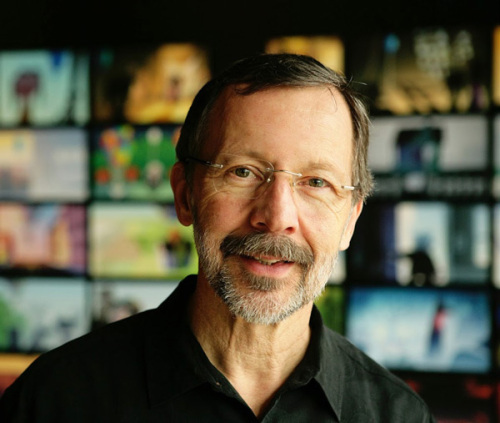
Ed Catmull, President and Co-Founder of Pixar.
NOTE TO E-MAIL SUBSCRIBERS: Please see this post in your inbox for a recording of the recent 2.5-hour live Q&A. Not on the email list? Sign up here and get extras like this for free.
Listen on iTunes, download (right click “save as”), or stream below now:
This podcast is brought to you by The Tim Ferriss Book Club, which features a handful of books that have changed my life. Here’s the list. You can also find all 20+ episodes of this podcast here. Some are sober and some are drunk, so you can roll the dice.
Now, on to our guest…
Ed Catmull is co-founder of Pixar Animation Studios (along with Steve Jobs and John Lasseter) and president of Pixar Animation and Disney Animation. Ed has received five Academy Awards, and — as a computer scientist — he has contributed to many important developments in computer graphics. He is the author of Creativity, Inc., which Forbes has said “just might be the best business book ever written.” (!)
This episode touches on a lot, including lessons learned from George Lucas and Steve Jobs, the origins of Pixar, personal challenges, routines, and much more.
Show notes and links are below. Enjoy!
Subscribe to The Tim Ferriss Show on iTunes.
Non-iTunes RSS feed
Do you enjoy this podcast? If so, please leave a short review here. It keeps me going…
Show Notes and Select Links from the Episode
Why Ed felt a sense of loss, despite a streak of successes after Toy Story in 1995
The misleading question most people ask themselves when they become “successful”
Why, after wanting to be an artist for most of his childhood, he switched his focus from animation to physics
The congruence of art, storytelling, and science
Why experiencing crises on each project is essential for building a strong, creative team
How Ed connected to the ancient tradition of oral storytelling due to his inability to read poetry
The importance of having “breadth” of knowledge while deep-diving into specialization
Stories of George Lucas’ innovative decisions
The arc in the mythology of Steve Jobs, and what everybody missed
Why Steve Jobs decided to take Pixar public one week after Toy Story’s opening
Which Pixar movies caused major challenges and had to be re-worked
Why all Pixar movies suck at the very early stages
Pixar’s secret to creating stories and movies
The one film Pixar abandoned and the reasons
The book Ed gifts most often
Ed’s daily meditation practice
Why he would not give his twenty-year-old self advice, even if he could
LINKS FROM THE EPISODE
Visit the Tim Ferriss Book Club to find a new book each month (or so) that’s changed my life
Learn more about Alfred Lee Loomis
Pixar Animation Studios
Disney
Find out more about George Lucas
Learn more about Steve Jobs
The Teaching Company
History of England from the Tudors to the Stuarts
Learn about Vipassana meditation
Books Mentioned in the Episode
Creativity, Inc. by Ed Catmull
The Hero’s Journey by Joseph Campbell
The Hero with a Thousand Faces by Joseph Campbell
One Monster After Another by Mercer Mayer

August 8, 2014
How to Never Check Luggage Again

Travel has many joys. Luggage is not one of them.
NOTE: If you signed up for my email list, please see this post in your email (perhaps on Saturday afternoon PT) for the Monday night Q&A info.
This post will explore three options for never checking luggage again. Some of them are extreme; all of them are effective.
In my next post, I’ll detail what I (and some friends) pack in carry-on. Some are surprising and hilarious.
Given that I spend 100+ days of the year traveling, and that I’ve been to 40+ countries, I’ve tested just about everything.
Hauling a five-piece Samsonite set around the planet is hell on earth. I watched a friend do this up and down dozens of subway and hotel staircases in Europe for three weeks, and — while I laughed a lot, especially when he resorted to just dragging or throwing his bags down stairs — I’d like to save you the breakdown. Trip enjoyment is inversely proportionate to the amount of crap (re: distractions) you bring with you.
So, how to avoid checked luggage altogether?
We’ll cover three different options, in descending order of craziness. I promise that something in this post will work for every one of you, even if partially:
– Using “urban caching” for travel purposes
– Mailing instead of checking (and some Steve Jobs-ian quirks)
– Ultralight packing
Many of these suggestions have been given to me by readers over the years, so thank you!
I try and bring such gifts full circle by collecting hundreds of tips, testing them, and publishing the winners.
So here we go…
Travel Caching
I was first introduced to the idea of “urban caching” by my friend Jason DeFillippo.
Remember the first Jason Bourne movie, when various agents are “activated” to kill Jason? One of them lands in Rome, where he accesses a hidden locker that contains everything he needs: a few passports, a gun, ammo, cash in small denominations, etc. That is an example of a single “cache.” (Yes, I’m somewhat obsessed with Jason Bourne)
Doomsday preppers (not derogatory) will often have multiple caches at various distances from a “bug out” departure point like a home or office. In the case of disaster — tornado, terrorism, zombies, Sharknado, etc. — they can set off walking empty-handed, if needed, and find everything they need waiting for them.
But how the hell do you apply this to regular travel? Ah, that’s where things get fun.
Let’s say that you’re flying to the same two cities 50-80% of the time, as I do. When I land in New York City, this is what I find already placed in my hotel room:

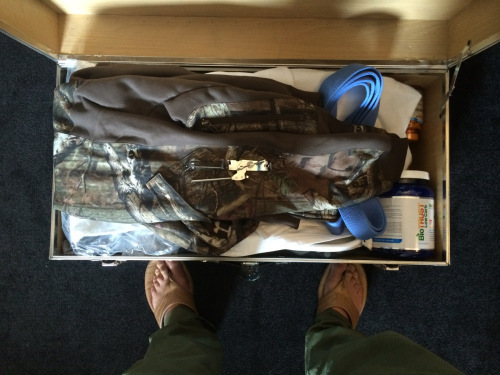
It is a trunk that contains almost everything I could need for a week. Believe it or not, it was provided and stenciled by the hotel. All I had to do was ask. (More tips on travel negotiating in the second half of this post)
I refer to this as “travel caching.”
I’ll explain how this can cost less than checking luggage, but let’s look at some key goodies first:
- One (1) winter jacket – I usually live in SF, where it is typically warmer most of the year.
- Cans of lentils and beans, pre-salted and spiced – I dislike waiting 30 minutes for $30 breakfasts. I use Amazon Prime to order Jyoti Dal Makhani or Westbrae organic lentils, having them mailed directly to the hotel. I eat directly out of the cans.
- Can opener and spoon
- Surge pocket multitool (do NOT put this in carry-on bags). No such thing as too many multitools.
- Jug of unflavored or vanilla whey protein, generally Bluebonnet or BioTrust. I find that whey in the mornings prevents me from getting sick when shifting time zones. It also helps me hit my “30 grams within 30 minutes” rule from The 4-Hour Body.
- L-lysine for immune support (especially after early or late flights), magnesium/ZMA and melatonin for sleep and jetlag.
- Lacrosse balls for rolling out my feet, upper back, chest, and forearms.
- Jiu-jitsu gi for getting my ass mercilessly kicked at the Marcelo Garcia Jiu-Jitsu academy.
- Four (4) collared shirts – I often travel to NYC for business or media.
- Four (4) decent t-shirts, including two V-neck t-shirts (I know, I know), that can used for lounging or casual dinners, etc.
- Socks and undies for one week.
- Two (2) pairs of dress shoes, one (1) pair athletic shoes, one (1) pair hiking boots for upstate adventures.
The best part: When I check out, I give a bag of dirty clothes to the front desk, they have it all cleaned and put *back* in my trunk, folded and pretty… ready for my next arrival! They charge it to the same credit card I have on file for rooms.
No packing, no checking, no unpacking, no cleaning. It’s magical.
So, how can this possibly save you money and sanity?
1) To check an equivalent amount of stuff would usually cost $30+, so $60+ roundtrip.
2) The clothing isn’t new clothing. Most of us have MUCH more clothing than we need. I simply leave one week’s worth of less-used stuff in NYC. No purchase necessary.
3) Two WEEKS worth of lentils, beans, and whey protein cost about the same as 2-4 DAYS of room service breakfasts. It’s also a ton faster. Waiting around makes Tim cray-cray.
4) If you stay in a hotel often enough, you can simply ask: “Do you have a trunk or something I could store a week’s worth of clothing in? That way, I wouldn’t have to pack so much when I come here.” The above trunk was given to me this way, but you can also buy one for $60 or so on Amazon, the equivalent of one trip’s baggage fees. Then ask the staff (who you should know by now) if you could store a week’s worth of clothing in the storage room, basement, or security office. This can also be arranged with many people on Airbnb.
And that, ladies and gentlemen, is travel caching. It’s a game-changer.
Mailing Instead of Checking
This is exactly what it sounds like.
Dean Jackson of the I Love Marketing podcast is the person who — for me — turned it into an art form.
The benefit of mailing versus caching: it’s not limited to your most frequent 2-3 destinations. It can be used anywhere, but it’s most often used domestically.
Not unlike Steve Jobs and his “uniform,” Dean literally wears the same outfit EVERY day: black t-shirt, tan shorts, orange Chuck Taylor shoes, and a black cap when cold. He doesn’t want to expend a single calorie making decisions related to fashion, which I respect tremendously. I’m a huge proponent of the choice-minimal lifestyle and rules to reduce overwhelm.
In his words via text, here’s how his packing and mailing works. Comments in brackets are mine:
“As you know, I wear the same thing every day…Black shirt, tan shorts…so I have my assistant keep a carry-on bag constantly packed for 7 days [TIM: It's a bag with 7 days worth of "uniforms"]. I use mesh laundry bags with a zipper to put together 7 “Day Packs” with a black shirt/underwear/socks [TIM: You can also use gallon-sized Ziploc bags]. Every day while traveling, I unzip a fresh new pack. When I return, she washes and repacks everything, and restocks my travel-only shaving kit with everything I need.
I have separate chargers, shoes, melatonin, etc., so I never have to pack…and she can ship my bag ahead of me without me having to do anything. Plus, she packs a pre-filled return FedEx shipping label for me, so I can — when I’m leaving — have a bellman come get my bag and take it to the business center to ship back.
That whole rig fits in a carry-on sized bag….7 Day Packs, 3 pairs of shorts, orange Chuck Taylors, charging cords, shaving kit…but that all gets shipped. Then my actual carry on is a Tumi laptop bag with Macbook, iPad, journal, passport, wallet. Using the Tumi, I don’t have to take out my laptop for x-rays, plus it’s beautiful leather with just the right pocket config.
It’s pretty light travel.”
Even if you never want to mail your bags ahead, there is one point you shouldn’t miss: It’s smart to have a travel-only toiletry kit that is never unpacked.
Keep one set of toothbrushes, toothpaste, etc. at home on the counters and shelves, and have a separate packed kit that is exclusively for travel.
This alone has saved me a ton of headache and last minute “Where is the closest CVS? I forgot my dental floss”-type nonsense.
Which brings us to the question of carry-on…
Ultralight Packing
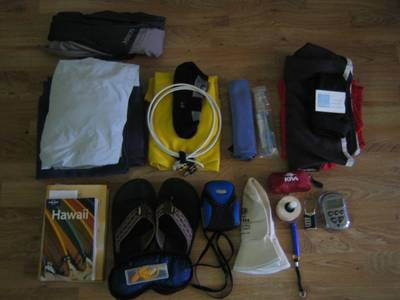
I’ll be expanding on this greatly, but, to start, please read one of my previously viral posts, “How to Travel the World with 10 Pounds or Less (Plus: How to Negotiate Convertibles and Luxury Treehouses).”
You’ll notice my “BIT” (Buy It There) method of travel seems to contradict the travel caching above, but they’re actually complementary.
BIT is ideal for traveling to places you’ve never been, or that you seldom visit. If it’s a third-world country where your currency is strong, all the better. Travel caching is for your 2-3 most frequently visited locations.
To get you in the mood for the above “10 pounds” post, here’s your first ultralight travel purchase: Exofficio underwear.
More soon…
###
Do you like this type of post? If so, please let me know in the comments.
Please also share your own tips!
If it seems you dig it, I’ll detail (at least) the following in my next post:
- My latest findings in ultralight packing
– My must-have carry-on items and subscription services
– Tools recommended to me by elite military and hedgefund managers
– My favorite bags
– Apps and other tricks that get me from home to gate in less than 20 minutes
Until then, start thinking up destinations.

August 5, 2014
Tim Ferriss Rethinks Email
Pretty soon, many of you will get an email from me. It’ll probably surprise you.
See, when I sketched out the original 4-Hour Workweek site in 2006 (sorely in need of a redesign), I included an email capture field, as that’s what friends said I should do:
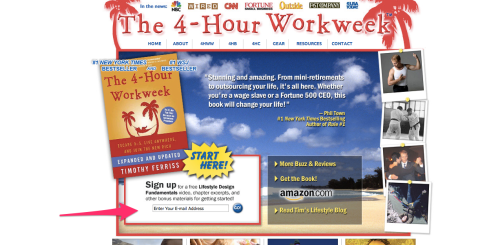
Then I promptly forgot all about it. I hated email, so I didn’t want to send you email. Simple as that. Do unto others, right?
But things have changed.
Now, with Twitter, Facebook, WhatsApp, and hundreds of clones, the Internet and mobile are a battlefield of noise. Even if you “like” my Facebook fan page, my updates will rarely reach more than 10% of you.
For years now, thousands of you have complained that Feedburner delivers time-sensitive blog posts days or WEEKS too late. This means missed giveaways, meetups, competitions, Q&As, parties, and all sorts of fun stuff.
Needless to say, this sucks.
So I reluctantly decided to re-examine email. In a world where people change email addresses less often than physical addresses, it just made sense.
My first step was to dust off the keyboard and log into AWeber, which I’d decided was best for me eight years prior. What I found shocked me. I had nearly 300,000 email addresses from sign-ups! Holy negligence, Batman!
Ah, well. Yet another reason for my friends to make fun of me. Enjoy, Kevin Rose.
But better late than never. Within the next 10 days, I will start emailing new blog posts to anyone who’s signed up (on the homepage or the newer blog form), generally around one post per week. Plus, you’ll get VIP treatment, like private Q&As, exclusive content, giveaways, and other things that don’t appear on the blog.
Here’s the deal:
- If you haven’t signed up yet (or you’re not sure), please do so now. Here’s the link. No spam, ever. Just good stuff.
If you sign up now, your first email will also include a link to a free download of the entire 4-Hour Chef audiobook, which includes narration by yours truly and Neil Gaiman (!). And to kick things off, I’ll be doing a 2-3-hour Q&A — for email subscribers only — next Monday night, 8/11. Ask me anything: business, personal, “inappropriate,” whatever. Nothing is off limits. Sign up here to get the details via email. A recording will be made available to email subscribers who can’t make the live session.
I’ll also be giving away a round-trip ticket to anywhere in the world. For details, you guessed it, you need to click here.
- If you’ve already signed up, you’re all set! Please keep an eye out for a welcome email from “Tim Ferriss” within the next 10 days.
It’s not spam. It’s from me. Following that, blog posts and VIP goodies will show up, roughly once per week.
If you’re using Gmail and my email ends up in your “Promotions” folder, please do me a favor and drag it to your “Primary” so it doesn’t get lost in all the OKCupid notifications and whatnot.
###
And please realize — I and my assistant get about 1,000 email a day. It’s funking unreal, and it’s brutal. No one is more sensitive to email abuse than I am, so I will NOT abuse your inbox.
If you get annoyed, you can one-click unsubscribe. Easy peasy and no BS.
Things will be intermittent (usually once a week, sometimes twice), and posts will be high-quality (like this or this).
As mentioned, I’ll be doing a 2-3-hour Q&A next week to kick things off, and also giving away a roundtrip ticket anywhere in the world. For details on both, just add your email here.
If you have any questions about all this, please ask in the comments! I’ll be paying close attention and answering as many as I can. I’ve literally put off email for years, but enough is enough. It’s the right thing to do.
And thank you for reading. Whatever this blog has become, I owe it all to you.
Pura vida,
Tim
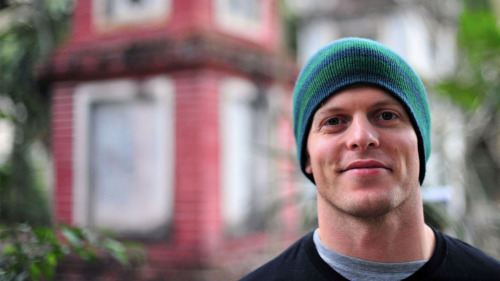

August 4, 2014
The Tim Ferriss Show, Episode 21: Mike Shinoda of Linkin Park – Making Art, Making Music, Getting To 60+ Million Albums
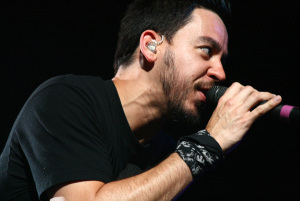
Mike Shinoda of Linkin Park.
Listen on iTunes, download (right click “save as”), or stream below now:
This podcast is brought to you by The Tim Ferriss Book Club, which features a handful of books that have changed my life. Here’s the list.
Now, on to our guest…
Mike Shinoda is best known as the rapper, principal songwriter, keyboardist, rhythm guitarist and one of the two vocalists (yes, an insane list) of Linkin Park, which has sold more than 60 million albums worldwide and earned two Grammy Awards in the process.
Mike has collaborated with everyone from Jay-Z to Depeche Mode, and he’s also the lead rapper in his side project Fort Minor, which I’m a huge fan of.
As if that’s not enough, he’s also provided artwork, production and mixing for all the projects mentioned above. The man is a beast… but did he start out that way? His answers might surprise you.
This episode covers how Mike got started, advice for aspiring musicians (or creatives/artists of any type), navigating “entertainment” and Hollywood, daily rituals, how he writes songs, how he rehearses, and much more.
Enjoy!
Subscribe to The Tim Ferriss Show on iTunes.
Non-iTunes RSS feed
Like these episodes? Want me to keep making them? Please leave a short review here. Even one sentence helps.
Show Notes and Select Links from Episode 20…
Mike’s first love, and what he thought he would do with his life
The humble, “boots-on-the-ground” beginnings of Linkin Park
From Linkin Park to Fort Minor, how Mike fills the void in music with what he wants to hear
How Linkin Park band members stood up to a major record label to get signed on their own terms
The story of how a few 19-year-old kids with red hair, tattoos, and facial piercings told Warner Brothers execs how to do their jobs
The importance of developing a fine-tuned radar for the subtle edits that can completely change your art into a “watered-down commercial nightmare”
An inside look at the various techniques to recording music
How songs are born
How Mike finds inspiration for his craft in things unrelated music
Why he will either delete your email or reply with a dissertation
Linkin Park’s rehearsal process
The software Linkin Park uses for rehearsals and shows
The one thing he would change about himself, if he could
And much more… Here’s the episode.
SELECT LINKS FROM EPISODE 20
Visit the Tim Ferriss Book Club to find a new book each month (or so) that’s changed my life
Fort Minor
Music for Relief – Non-profit org founded by Linkin Park
DJI Phantom 2 Vision Quadcopter
Ableton Live 9
This American Life
Learn more about Rick Rubin
Chase Jarvis’ Official Site
Linkin Park | Facebook | Instagram | Twitter
Mike Shinoda | Facebook | Instagram | Twitter
Books Mentioned in the Episode
The Tipping Point by Malcolm Gladwell
Blink by Malcolm Gladwell
Becoming a Category of One by Joe Calloway
Learning Not to Drown by Anna Shinoda
Music Mentioned in the Episode
Check out Mike Shinoda’s Spotify and Beats playlists
Mongol Horde
Doom Riders
Royal Blood
Movies Mentioned in the Episode
The Godfather
The Usual Suspects
Fight Club
Seven
Akira
Wall-E
Ninja Scroll
Mall directed by Joe Hahn of Linkin Park








